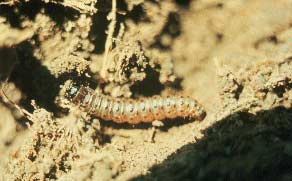
Sod webworms have four stages in their life cycle: egg, larva (or caterpillar), pupa, and adult (a moth). The buff-colored moths are 1/2" to 1" long. Their wings are held close around the body and there are two feelers (palpi) that project forward like a snout from the head. When disturbed, the moths fly short distances in a jerky, zig-zag manner and then quickly hide again in the grass.
Female moths fly at night and drop their tiny eggs randomly over the lawn. The eggs hatch in about a week and the small larvae begin to feed.
Larvae are gray with small dark spots on the body and a dark head. Fully developed webworms are about 3/4" to 1" long. They live in silk-lined tubes found near the soil line. The tubes are covered with bits of grass. Mature larvae pupate in the tube prior to emerging as adults.
There are three generations a year. The first two generations take from 4 to 8 weeks for completion, depending on weather conditions. The last summer generation passes the winter as a larva or pupa.
Webworms can attack popcorn following sod. These light-gray, spotted caterpillars insects feed in the same manner as cutworms.
Webworms may be found surrounded by a loose silken sack covered with soil particles. The added protection of the sack makes control by contact insecticides more difficult. Capture, Mustang, and Lorsban are specifically labeled for this pest, however, products registered for cutworm control on corn should be effective, also. A basal spray should enhance control.